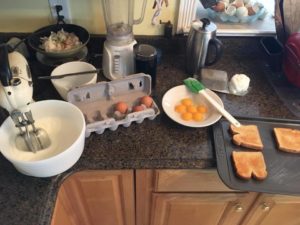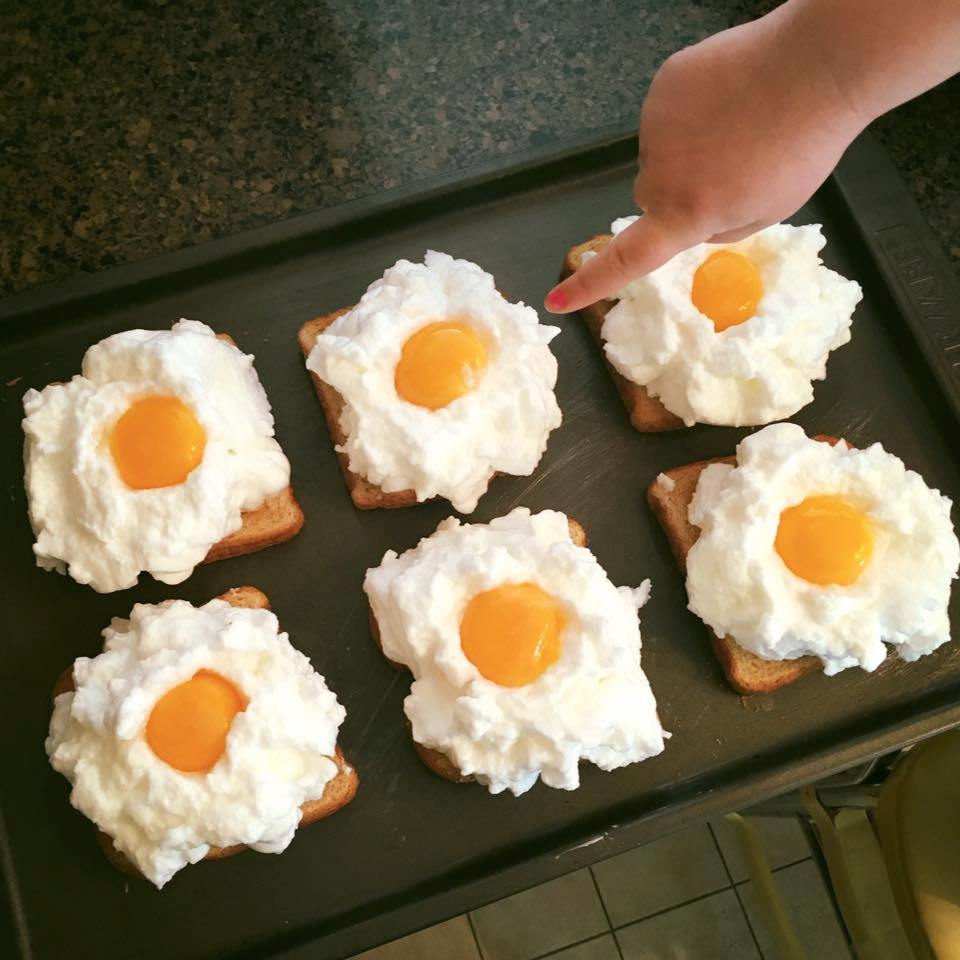Snow days, birthdays, and other holidays and observances are special days for me, and on special days, I like to make special breakfasts, usually including my favorite breakfast dish in the whole entire universe (scrapple being a very, very close second) — daisy eggs.
and other holidays and observances are special days for me, and on special days, I like to make special breakfasts, usually including my favorite breakfast dish in the whole entire universe (scrapple being a very, very close second) — daisy eggs.
They’re a bit of work, but make the rest of the day seem like something more than it might be, another chance to be here—all here, all now, just me and my breakfast against the forces of gloom in the world.
The recipe:
It’s more of a methodology than a recipe, really, since this is essentially just a tarted-up version of eggs on toast. I’ll give the process for one egg and you can just scale it up as you like. Also — warning! — you must be the kind of person who likes your yolks saucy to enjoy these eggs, because if you cook the yolks firm on this, it just ends up as a strange awful dry hunk of insulation with a golf ball inside.
You’ll need, for each:
• An egg, preferably a free-range organic, locally farmed, or backyard chicken egg (because it’s joyless to torture chickens). Brown, blue, or green ones don’t taste different, as best I can tell, but they add nice earth tones to the cooking process.
• A well-toasted slice of bread, and not not not that awful gummy white atrocity that most people mistake for bread. On the same token, you don’t want to use bread that’s too firm, healthy, and/or nutty or seedy for this, because it fights against the natural waft and airiness of the meringue. I normally use a firm textured, sprouted wheat bread around the house, but those have a little too much personality as a base for daisy eggs. Stick with a nice firm-textured italian or italian bread, challah, or a hearty farmhouse white and you’ll be just fine.
• A bit of milk, roughly a tablespoon’s worth. Oat or other nutmilks work here.
• A slightly greased cookie sheet. I use butter, but a sheen of oil or fat of some other variety works fine.
• A mixer. You could also use a balloon whisk for this if you are very patient and have a nice big bowl to whisk in. I use a 1952 Hamilton Beach mixer that I bought at a thrift store for $4.
The assembly process:
Preheat the oven to 400F (this varies, but that’s about right).
Toast your bread, then place it on the greased cookie sheet.
Separate your egg white from your yolk—be very careful not to break the yolk, because a broken yolk will seep through the meringue and make a weird sort of omelet under the toast, ruining the effect of the daisy egg. You’ll want to try to get all the white separated off, because jiggly raw egg white is inelegant around a perfect yolk. Set the yolk aside. Whip your whites in the mixer until you get foamy meringue, but don’t overbeat them or they’ll get all clumpy and stiff.
Whip your whites in the mixer until you get foamy meringue, but don’t overbeat them or they’ll get all clumpy and stiff.
Practice makes perfect here.
Drizzle a tablespoon of milk onto the toast, soaking it through.
Then, with a rubber spatula or equivalent, make a big blob of meringue on the toast. You’ll probably do the final shaping with your hands, which can be a messy process, but that’s okay. When you’ve got a lovely cloud there, you’ll want to dig a little yolk-divot into the center. It should be smooth and deep, but not too deep. When it’s ready, carefully drop your yolk into the divot, being careful not to break it.

Put the cookie sheet in the oven for about 7-10 minutes (watch this process with care, as the time varies a good bit on local conditions). You want to take it out when the meringue gets golden peaks but well before the yolk starts to solidify.
Admire the view, hit ’em with a little salt and pepper, chop ’em up, and dig in while they’re warm. There’s absolutely nothing exotic about these eggs except for the extra labor, but they feel special, and make a morning special, and that’s a fantastic thing.
©2003 Joe Belknap Wall

